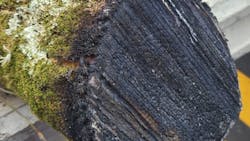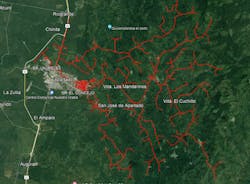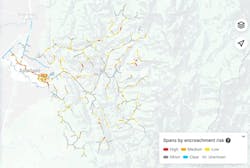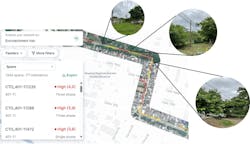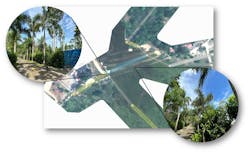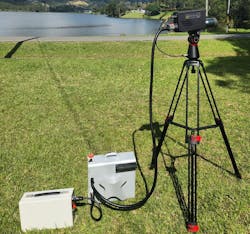Columbian Utility Adopts Laser Trimming Technology
Key Highlights
- Satellite imagery enables precise, real-time vegetation monitoring, improving decision-making and reducing service disruptions.
- LOR technology allows remote, safe trimming of trees, minimizing risks to workers and environmental impact.
- The integration of these technologies enhances operational efficiency, reduces costs, and promotes safety in vegetation management.
- EPM's proactive, data-driven approach sets a regional benchmark, inspiring other utilities to modernize their practices.
- Ongoing workforce training and regulatory collaboration ensure sustainable, environmentally responsible technology deployment.
The timely adoption and effective use of advanced technologies in vegetation lifecycle management for transmission and distribution lines offer significant benefits to utilities, helping them address challenges related to service quality, resource efficiency, infrastructure security and personnel safety. As electrical networks grow in complexity and demand for service reliability increases, emerging technologies play a crucial role in maintaining high standards of safety, sustainability and operational efficiency. Over the years, technological advancements have become essential for improving performance, reducing downtime and enhancing worker safety.
Empresas Públicas de Medellín (EPM), a Colombian utility company, is integrating innovative technologies into its vegetation management (VM) processes. By leveraging satellite imagery for vegetation analysis and introducing Laser Obstacle Remover (LOR) technology to enhance trimming operations, EPM is actively addressing the evolving needs of modern VM.
Satellite Tools
Effective VM starts long before trimming operations. At EPM, strategic initiative-taking planning is a key priority to ensure the efficiency and success of VM efforts. One of the most impactful technological tools currently being evaluated is satellite imagery analysis, which has significantly improved vegetation monitoring and resource optimization.
Satellite imagery enables precise vegetation monitoring around transmission and distribution lines, providing accurate, up-to-date data for decision-making. By leveraging detailed mapping, utilities can identify areas of concern and predict potential risks and optimize operational resources across the entire vegetation management lifecycle. In addition, they can generate risk reports, integrating vegetation threat analysis with network vulnerability indicators (e.g., bare overhead lines, critical users and remote areas).
This data-driven approach allows to monitor vast areas quickly and efficiently, ensuring that VM shifts from a reactive to a proactive process. By using satellite imagery, EPM can minimize service disruptions caused by vegetation interference, optimizing costs and time in the process.
Past Evaluations, Current Advancements
In previous years, LiDAR + drone solutions were tested in EPM’s VM strategy, as was discussed in an article, “Technology Advances a Tropical Country’s VM,” in the 2021 T&D World Vegetation Management Supplement. While the technology delivered promising technical results, logistical and cost challenges prevented widespread adoption.
Currently, traditional vegetation monitoring relies on manual field inspections, which are time-consuming, costly and limited in scope. By integrating satellite imagery, EPM aims to significantly improve inspection efficiency and accuracy, allowing for real-time vegetation health assessments over large areas. This results in reduced inspection time compared to pedestrian-based monitoring and more precise and strategic pruning activities, minimizing service interruptions.
Pilot Project and Beyond
In Q2 2023, EPM collaborated with an analytics company to conduct a pilot project in one of the most critical circuits in the west region of the Antioquia department. Within just two months, a comprehensive encroachment risk report was generated, categorizing risks from low to high. Field validations confirmed an important level of accuracy.
Additional benefits included assessing the phytosanitary condition of surrounding trees, enabling proactive measures to prevent tree falls and identifying GIS data inconsistencies, a common challenge in extensive network systems.
The next phase involves expanding implementation to a larger area (thousands of kilometers) to gather performance insights and define the optimal integration of this technology into EPM’s operational processes.
Laser Obstacle Remover (LOR)
In 2024, EPM introduced Laser Obstacle Remover (LOR) technology for vegetation management. LOR uses a precision laser beam to remotely trim vegetation, particularly tree branches that pose a risk to power lines. Traditional pruning methods often require workers to climb trees or operate near live power lines, exposing them to safety hazards. LOR technology eliminates these risks by enabling remote-controlled trimming.
EPM adopted a methodical approach to LOR implementation, which included technological surveillance and industry research, Proof of Concept (PoC) testing to validate effectiveness and acquisition and employee training for safe and efficient deployment.
The results have been highly beneficial, offering improvements in:
- Tree Health: LOR enables precise and controlled trimming, avoiding excessive cutting that can harm trees. Unlike traditional pruning, which can weaken vegetation, LOR targets only specific branches, preserving tree structure and reducing environmental impact. Additionally, as this technology does not require tree climbing, it minimizes potential physical damage to trees.
- Personnel Safety: Safety is a primary concern in vegetation management, especially near electrical infrastructure. Traditional methods expose workers to electrocution risks, falls, and other hazards. With LOR technology, trimming is performed remotely, eliminating direct interaction with live wires. Work at height is reduced, significantly lowering the risk of injuries, and overall work conditions are safer, ensuring better protection for field crews.
- Operational Efficiency: LOR increases efficiency and speed in vegetation management by reducing manual labor requirements and operational delays. It also enhances precision, ensuring only necessary branches are removed, and minimizes service interruptions, improving reliability. This technology is especially beneficial in hard-to-reach areas, where traditional trimming methods are difficult or costly. Remote-controlled laser trimming enhances accessibility, reduces downtime and optimizes resources.
- Cost Savings: By decreasing manual labor and specialized equipment needs, LOR technology could offer significant cost savings. The reduced maintenance requirements further lower operational expenses. Additionally, fewer service disruptions translate into fewer customer complaints and improved service continuity.
By integrating LOR into its vegetation management practices, EPM has taken a major step forward in safety, sustainability and operational excellence.
Continuing Technological Integration
Looking ahead, EPM is committed to continuing the development of its technological management process for LOR. The company plans to focus on adapting internal processes and integrating human capital to fully leverage this new technology's potential. EPM recognizes that the effective use of advanced technologies requires not only the right tools but also an empowered workforce capable of maximizing their potential.
As part of this ongoing development, proper training and process adaptation will be crucial in ensuring that field crews and managers can make the most of the new technology. By continuously investing in workforce development and embracing change, it can ensure that its vegetation management program remains at the forefront of innovation.
EPM’s long-term vision for technological integration also involves continuous collaboration with environmental authorities; this ensures that innovative technologies, especially LOR, are in line with environmental regulations and standards. EPM is committed to minimizing the environmental impact of its operations while ensuring that its technological solutions contribute to long-term sustainability. By maintaining an open dialogue with regulators, EPM can address concerns and adapt its practices to promote ecological balance.
A Pioneer in Latin America
EPM has taken on the role of a pioneer in the Latin American region by being one of the first utilities to integrate these technologies into its vegetation management processes. This leadership in technological innovation highlights EPM’s commitment to providing service while continuously improving its operational efficiency and safety standards.
Through the combined use of satellite imagery for vegetation analysis and LOR technology for trimming, EPM has set a new standard in the region for utilities aiming to modernize and enhance their vegetation management processes. These technologies are not only helping to improve efficiency and safety but are also paving the way for a more sustainable, data-driven approach to vegetation management. By using these cutting-edge solutions, EPM is working to ensure that it can meet the evolving needs of its customers while minimizing service disruptions and reducing costs.
Modernizing VM
The adoption of satellite imagery and LOR technology represents a transformational shift in vegetation management. These innovations could significantly improve service quality by reducing vegetation-related disruptions; operational efficiency through proactive monitoring and precision trimming and worker safety by minimizing exposure to hazardous conditions.
EPM’s proactive approach provides valuable insights for global utilities, demonstrating how technological solutions can address long-standing challenges while ensuring safety and environmental responsibility.
The successful adoption of these technologies offers valuable insights for utilities around the world, demonstrating how new technological solutions can help address long-standing challenges in vegetation management while maintaining a focus on safety and environmental responsibility. The lessons learned from EPM’s experience serve as a roadmap for other utilities aiming to modernize their processes, improve service reliability and adopt more efficient practices. EPM’s ongoing dedication to technology-driven improvements sets an excellent example for the future of vegetation management in Latin America.
About the Author
Diego Mauricio Tauta Rúa
Diego Mauricio Tauta Rúa ([email protected]) is a team leader-technology management for Empresas Públicas de Medellín (EPM). He is an electrical engineer from the National University of Colombia, with more than 17 years of experience in the utilities infrastructure sector. He holds a master’s degree in electrical engineering and a master’s degree in technological innovation management. For more than seven years, he has led technological innovation management at EPM, driving advancements in the industry. In addition, he has been a university professor for more than nine years, specializing in research on innovation and technology management in the transmission and distribution (T&D) sector, with several publications on the topic.
Elizabeth Jaramillo Marín
Elizabeth Jaramillo Marín ([email protected]) is a technology management professional for EPM. She is an industrial engineer from the University of Antioquia in Colombia and holds a master’s degree in industrial engineering from the Polytechnic University of Turin in Italy. With more than 10 years of experience in technology management at EPM, she has developed a strong expertise in leading and implementing technological innovations to improve operational efficiency and service quality. Throughout her career, Elizabeth has focused on integrating advanced technologies into business processes, ensuring alignment with strategic goals and fostering continuous improvement in organizational performance.
